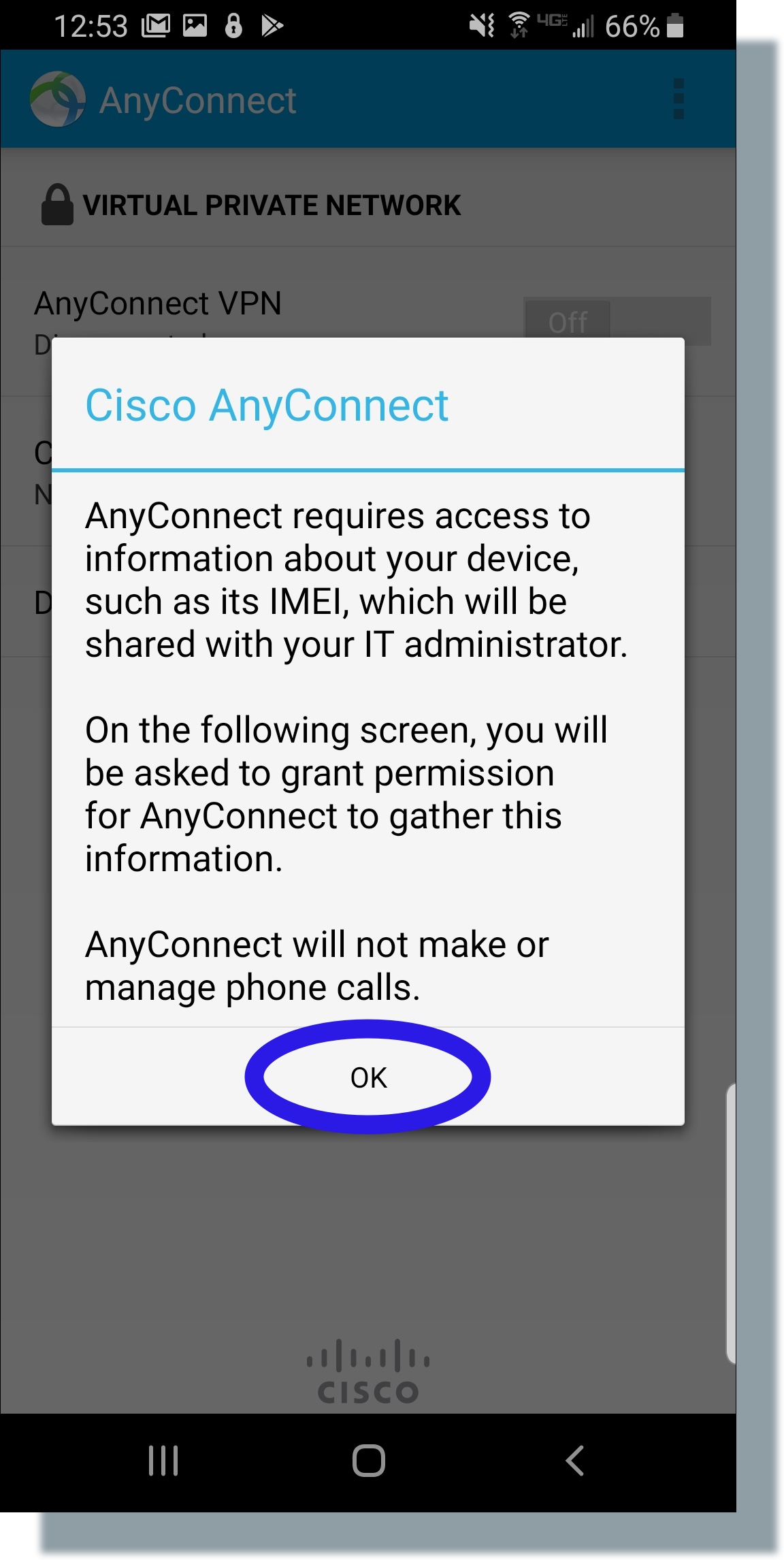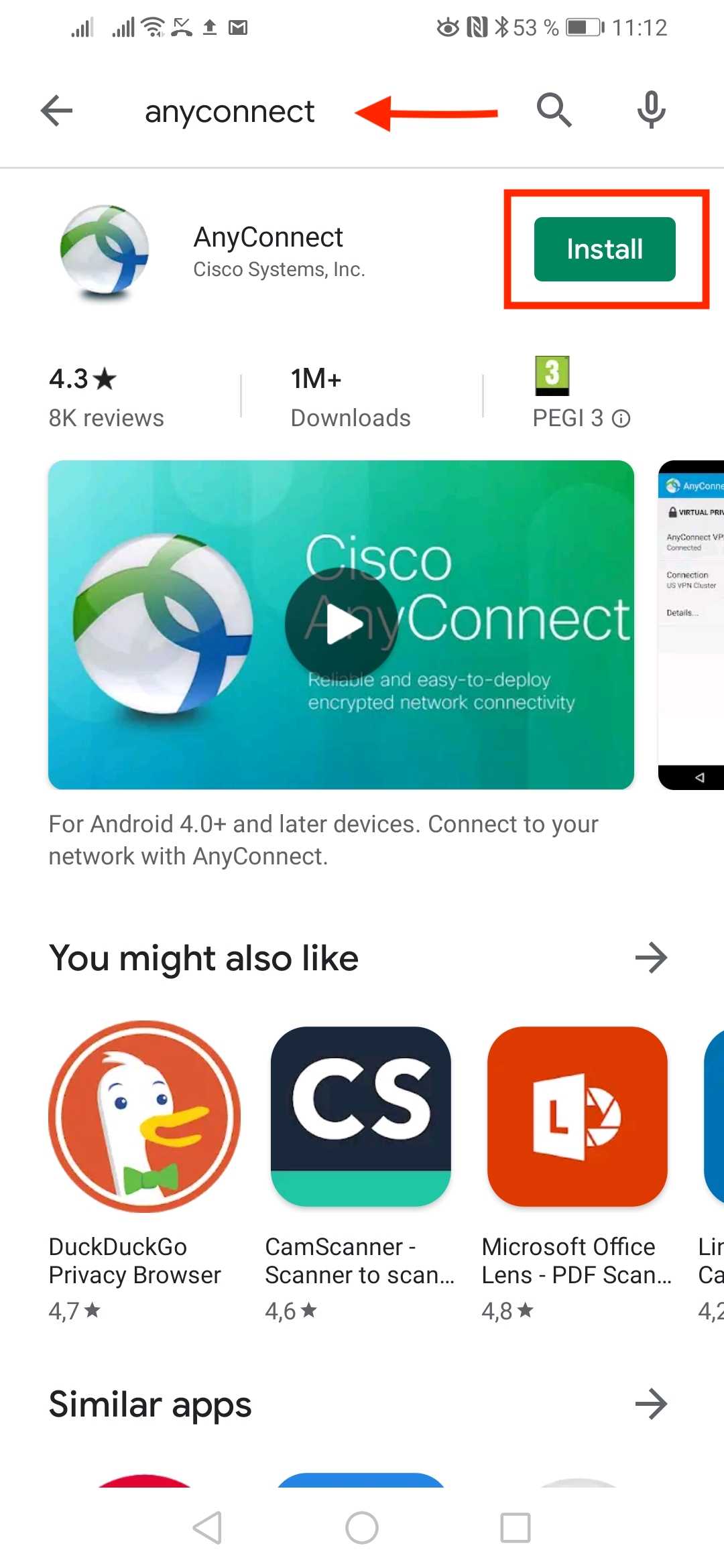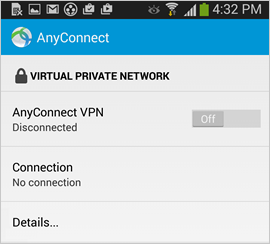- Anyconnect For Android
- Cisco Anyconnect Android Setup Free
- Cisco Anyconnect Android Setup Instructions
- Cisco Anyconnect Android Setup Download
Overview

Stanford's VPN allows you to connect to Stanford's network as if you were on campus, making access to restricted services possible. To connect to the VPN from your Windows computer you need to install the Cisco AnyConnect VPN client.

Dear All, In our company we are providing VPN connection to our employees. VPN connection works fine with iPad and iPhone. Images below shows the configuration for iPad. I need to configure that for Android 'Galaxy' as I tried that but I couldn't. Looking to hear from you. Your help is appreciat. Connect your Android device to the Internet. Using a browser on your Android device, open select the dCloud location nearest to you, and log in with your Cisco.com credentials. In dCloud, select My Dashboard My Sessions, find the active session, and click View under the session. How To Setup Cisco Vpn Client On Android hackers try to steal your information or your Bitcoin - you need to protect yourself with a encrypted VPN connection when you access the internet. We give you a market overview as well as a serious guide on which companies to choose How To Setup Cisco Vpn Client On Android. Android devices must be under MDM management in order to deploy the app and configuration. This client supports Android OS v6.0.1 and later. Unmanaged device support is planned for future releases. The Umbrella Android Client requires Cisco AnyConnect 4.8 or later. For more information, refer to Cisco Umbrella Android Client documentation. At the moment, no. AFAIK Cisco has not made any official statement regarding support for Android, but Samsung has announced that it is working with Cisco to get Anyconnect to run on some of its Galaxy and Tab models, I believe it will be available from the Android marketplace when ready.
Anyconnect For Android
Two types of VPN are available:
- Default Stanford (split-tunnel). When using Stanford's VPN from home, we generally recommend using the Default Stanford split-tunnel VPN. This routes and encrypts all traffic going to Stanford sites and systems through the Stanford network as if you were on campus. All non-Stanford traffic proceeds to its destination directly.
- Full Traffic (non-split-tunnel). This encrypts all internet traffic from your computer but may inadvertently block you from using resources on your local network, such as a networked printer at home. If you are traveling or using wi-fi in an untrusted location like a coffee shop or hotel, you may wish to encrypt all of your internet traffic through the Full Traffic non-split-tunnel VPN to provide an additional layer of security.

You can select the type of VPN you want to use each time you connect to the Stanford Public VPN.
Install the VPN client
- Download the Cisco AnyConnect VPN for Windows installer.
- Double-click the InstallAnyConnect.exe file.
- When a message saying the Cisco AnyConnect client has been installed, click OK.
Connect to the Stanford VPN
Cisco Anyconnect Android Setup Free
- Launch the Cisco AnyConnect Secure Mobility Client client.
If you don't see Cisco AnyConnect Secure Mobility Client in the list of programs, navigate to Cisco > Cisco AnyConnect Secure Mobility Client. - When prompted for a VPN, enter su-vpn.stanford.edu and then click Connect.
- Enter the following information and then click OK:
- Group: select Default Stanford split- tunnel (non-Stanford traffic flows normally on an unencrypted internet connection) or Full Traffic non-split-tunnel (all internet traffic flows through the VPN connection)
- Username: your SUNet ID
- Password: your SUNet ID password
- Next, the prompt for two-step authentication displays. Enter a passcode or enter the number that corresponds to another option(in this example, enter 1 to authenticate using Duo Push to an iPad). Then click Continue.
- You may have to scroll down the list to see all of your options.
- If your only registered authentication method is printed list, hardware token, or Google Authenticator, the menu does not display. Enter a passcode in the Answer field and click Continue.
- Click Accept to connect to the Stanford Public VPN service.
- Once the VPN connection is established, a message displays in the lower-right corner of your screen, informing you that you are now connected to the VPN.
Disconnect from the Stanford VPN
- In the notification area, click the Cisco AnyConnect icon if it is displayed. Otherwise, go to your list of programs and click Cisco AnyConnect Secure Mobility Client.
- At the prompt, click Disconnect.
You need to use the Cisco AnyConnect app to connect to the Stanford VPN. This app works with most Android devices. However, the AnyConnect app is not guaranteed to work on all Android devices due to the wide variety of Androids available.
Before you can connect to the Stanford VPN you should:
- Install Mobile Device Management (MDM) on your Android device
- Install the free Cisco AnyConnect app
- Configure the AnyConnect app for the Stanford VPN
Install MDM
Install and configure AnyConnect
Cisco Anyconnect Android Setup Instructions
- Go to the Google Play Store and search for Cisco AnyConnect.
- Choose the AnyConnect ICS+ app and tap Install.
Note: Our testing shows that AnyConnect ICS+ does not work with HTC Android devices. - If prompted, tap Accept to give AnyConnect permission to access other apps.
- Tap Open and accept the license agreement if one is presented.
- Choose to add a new VPN connection by tapping Connection.
- If the Advanced Preferences screen displays, tap Add a New VPN Connection.
- Enter the following information:
- Description: label the configuration with a unique identifier (for example, Stanford VPN)
- Server Address: https://su-vpn.stanford.edu
- Tap Done.
Connect to the Stanford VPN

- Open the AnyConnect app.
- Tap the AnyConnect VPN Off button.
- When prompted for your username and password, enter the following and then tap Connect:
- Group: choose Default Stanford split-tunnel or Full Traffic (non-split-tunnel)
- Default Stanford split-tunnel: access to anything at stanford.edu is via the VPN connection but non-Stanford traffic flows normally on an unencrypted internet connection.
- Full traffic non-split-tunnel: all internet traffic flows through the VPN connection.
- Username: your SUNet ID
- Password: your SUNet ID password
- Group: choose Default Stanford split-tunnel or Full Traffic (non-split-tunnel)
- Next the prompt for two-step authentication displays.
- Enter a passcode or enter the number that corresponds to another option and then tap Continue (in this example, enter 1 to authenticate using Duo Push).
- If your only registered authentication method is printed list, hardware token, or Google Authenticator, the list of options does not display. Enter a passcode and tap Continue.
- You may see a truncated menu if you have multiple two-step devices enabled. Enter a passcode or choose a second factor from the options provided and then tap Continue (in this example, enter push1 to authenticate using Duo Push).
Note: It may take a bit of trial and error to associate secondary factors with devices.
- Enter a passcode or enter the number that corresponds to another option and then tap Continue (in this example, enter 1 to authenticate using Duo Push).
- Tap Accept to connect to the Stanford VPN.
- If you see a message seeking your attention, tap I trust this application and then tap OK.
- When you are connected to VPN, the AnyConnect app shows the VPN as turned on.
Disconnect from the Stanford VPN
Cisco Anyconnect Android Setup Download
To disconnect from the Stanford VPN, open the AnyConnect app and tap the On button. It toggles to Off, disconnecting your device from the Stanford VPN.

Comments are closed.